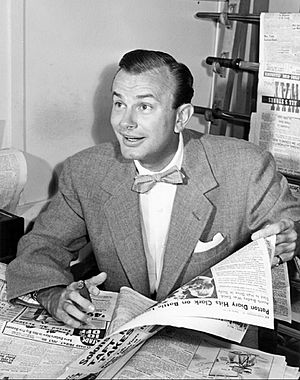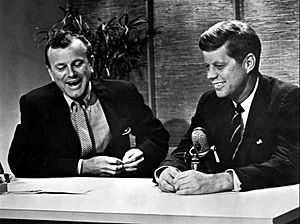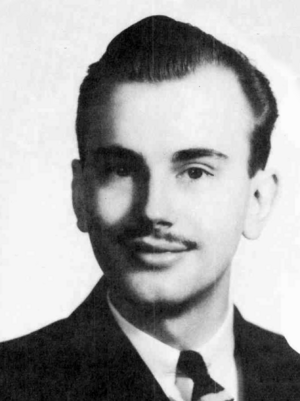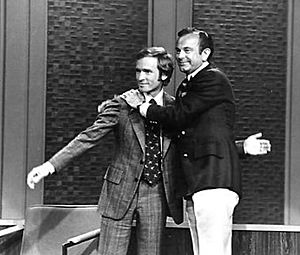Jack Paar facts for kids
Quick facts for kids Jack Paar |
|
|---|---|

Paar circa early 1950s
|
|
| Birth name | Jack Harold Paar |
| Born | May 1, 1918 Canton, Ohio, U.S. |
| Died | January 27, 2004 (aged 85) Greenwich, Connecticut, U.S. |
| Medium | Television Film Memoirs |
| Nationality | American |
| Genres | Observational comedy |
| Subject(s) | Everyday life, American culture |
| Spouse | Irene Gubbins (twice divorced) Miriam Wagner
(m. 1943) |
| Children | 1 |
Jack Harold Paar (born May 1, 1918 – died January 27, 2004) was a famous American TV host, writer, and comedian. He is best known as the second host of The Tonight Show from 1957 to 1962. Many people remember him for changing how talk shows worked.
Contents
Early life and growing up
Jack Paar was born in 1918 in Canton, Ohio. When he was a child, his family moved to Jackson, Michigan. He had a stutter when he was young, but he learned to control it. At 14, he got tuberculosis, a serious illness. He left school when he was 16 years old.
Career in entertainment
Starting out in radio
Jack Paar began his career as a radio announcer in Jackson, Michigan. He was known for being funny. Once, on April Fool's Day, a newspaper staff played a trick on him. They printed a fake story about an "Arabian potentate" named "Loof Lirpa" visiting town. Jack read it on air, only to find out "Loof Lirpa" was "April Fool" spelled backward!
He later became a humorous disc jockey (someone who plays music and talks on the radio) at stations in other cities like Detroit and Cleveland. During World War II, Jack joined the Army in 1943. He worked for the U.S.O. (United Service Organizations), entertaining soldiers in the South Pacific. He was a very clever and witty host for these shows.
Radio and movies
After the war, Jack Paar wanted to work in bigger radio shows and movies. He filled in as a host on popular radio shows like The Breakfast Club. He also hosted a game show called Take It or Leave It.
A famous comedian named Jack Benny was impressed by Jack Paar. Benny suggested Paar take over his show for the summer in 1947. Paar was a big hit! He later appeared in movies, often as a host or a friendly character. In 1951, he even played Marilyn Monroe's boyfriend in the movie Love Nest.
Becoming a TV star
Jack Paar first appeared on television in the early 1950s. He was a comedian on The Ed Sullivan Show. He also hosted a few game shows and a morning show on CBS.
Hosting The Tonight Show
In 1957, Jack Paar got his biggest job: hosting The Tonight Show on NBC. The show was renamed Tonight Starring Jack Paar. It quickly became very popular and made a lot of money for the network.
Jack Paar was known for being unpredictable and emotional. He was also very principled. In 1960, network censors cut a joke from his show without telling him. In protest, Jack walked off the show the next night! He didn't come back for three weeks, until the network apologized and let him tell the joke. This event made national news.
Hosting a 105-minute show every night was very tiring for him. He left The Tonight Show on March 29, 1962. He later said that leaving the show was the biggest mistake he ever made.
Prime time success
NBC didn't want to lose Jack Paar, so they offered him his own show in prime time (the evening hours when most people watch TV). This new show, The Jack Paar Program, started in 1962. It was different because it showed acts from all over the world and films from exotic places.
Jack Paar was one of the first to show film clips of The Beatles performing in the U.S. This was a month before their famous live appearance on The Ed Sullivan Show.
His prime time show ran for three years. It featured many famous guests like comedian Bill Cosby, actor Richard Burton, and boxing champion Muhammad Ali. In his final show on June 25, 1965, Jack Paar sat alone on a stool. He talked about leaving and then walked off with his German Shepherd dog, Leica.
Later career
In the late 1960s, Jack Paar owned and ran a TV station in Maine.
He returned to television in 1973 with a show called Jack Paar Tonite. It aired once a month. He said he would only do it if ABC kept his former writer, Dick Cavett, on the air. He stayed for one year but then quit because he didn't like the rotating schedule.
In the 1980s and 1990s, Jack Paar made rare guest appearances on other talk shows, like Late Night with David Letterman. On Letterman's show, he showed a dressing room where Jim Henson and his puppeteers had drawn on pipes many years earlier while waiting to appear on Paar's program. NBC has saved these pipes as part of their studio tour.
Looking back at his work

In 1984, Jack Paar came out of retirement for a special tribute to him. This led to two NBC TV specials in 1986 and 1987, called Jack Paar Comes Home and Jack Paar Is Alive and Well. These shows featured many old clips from his Tonight Show and prime time program.
In 1997, the PBS network made a TV show about Jack Paar's career. In 2003, they made another show about his work called Smart Television.
Awards and recognition
Jack Paar was nominated for an Emmy award twice for his performances in 1951 and 1958. An Emmy is a major award for television shows. He did not win either time, but being nominated showed how talented he was.
Personal life and passing
Jack Paar was married twice to his first wife, Irene. They divorced and remarried, then divorced again. He then married Miriam Wagner in 1943, and they stayed together until he passed away. They had one child, a daughter named Randy.
In his later years, Jack Paar's health declined. He had heart surgery in 1998 and a stroke in 2003. He passed away in 2004 at his home in Greenwich, Connecticut, at the age of 85. His wife Miriam and daughter Randy were with him.
See also
 In Spanish: Jack Paar para niños
In Spanish: Jack Paar para niños



